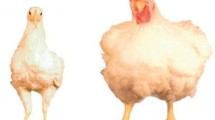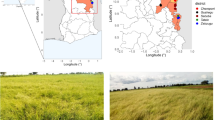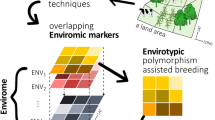Abstract
Genetic diversity within and between breeds (and lines) of pigs was investigated. The sample comprised 68 European domestic breeds (and lines), including 29 local breeds, 18 varieties of major international breeds, namely Duroc, Hampshire, Landrace, Large White and Piétrain, and 21 commercial lines either purebred or synthetic, to which the Chinese Meishan and a sample of European wild pig were added. On average 46 animals per breed were sampled (range 12–68). The genetic markers were microsatellites (50 loci) and AFLP (amplified fragment length polymorphism, 148 loci). The analysis of diversity showed that the local breeds accounted for 56% of the total European between-breed microsatellite diversity, and slightly less for AFLP, followed by commercial lines and international breeds. Conversely, the group of international breeds contributed most to within-breed diversity, followed by commercial lines and local breeds. Individual breed contributions to the overall European between- and within-breed diversity were estimated. The range in between-breed diversity contributions among the 68 breeds was 0.04–3.94% for microsatellites and 0.24–2.94% for AFLP. The within-breed diversity contributions varied very little for both types of markers, but microsatellite contributions were negatively correlated with the between-breed contributions, so care is needed in balancing the two types of contribution when making conservation decisions. By taking into account the risks of extinction of the 29 local breeds, a cryopreservation potential (priority) was estimated for each of them.
Similar content being viewed by others
References
Alderson L (2003) Criteria for the recognition and prioritisation of breeds of special genetic importance. Animal Genetic Resources Information 33:1–9
Barker JSF (2001) Conservation and management of genetic diversity: a domestic animal perspective. Can. J. For. Res. 31:588–595
Barker JSF, (2002). Relevance of animal genetic resources and differences to the plant sector. In: Groeneveld E, Glodek P, (eds), Animal Breeding and Animal Genetic Resources. Federal Agricultural Research Centre (FAL), Mariensee and Institute of Animal Genetics, Göttingen, Braunschweig, Germany, pp. 15–21
Barker JSF, Hill WG, Bradley D, Nei M, Fries R, Wayne RK (1998) Measurement of domestic animal diversity (MoDAD): original working group report. FAO, Rome
Barker JSF, Tan SG, Moore SS, Mukherjee TK, Matheson JL, Selvaraj OS (2001) Genetic variation within and relationships among populations of Asian goats. J. Anim. Breed. Genet. 118:213–233
Bataillon TM, David JL, Schoen DJ (1996) Neutral genetic markers and conservation genetics: simulated germplasm collections. Genetics 144:409–417
Caballero A, Toro MA (2002) Analysis of genetic diversity for the management of conserved subdivided populations. Conserv Genet. 3:289–299
Canon J, Alexandrino P, Bessa I, Carlos C, Carretero Y, Dunner S, Ferran N, Garcia D, Jordana D, Laloë D, Pereira A, Sanchez A, Moazami-Goudarzi K (2001) Genetic diversity measures of local European beef cattle breeds for conservation purposes. Genet. Sel. Evol. 33:311–322
Chaiwong N, Kinghorn BP (1999) Use of genetic markers to aid conservation decisions for groups of rare domestic breeds. Proc. Assoc. Advmt. Anim. Breed. Genet. 13:365–368
Derban S, Foulley JL, Ollivier L (2002) WEITZPRO: a software for analysing genetic diversity. INRA, Paris
EAAP – Working Group on Animal Genetic Resources (1998) Assessment of the degree of endangerment of livestock breeds. Book of Abstracts of the 49th Annual Meeting of the European Association for Animal Production, 40
Eding H, Meuwissen THE (2001) Marker-based estimates of between and within population kinship for the conservation of genetic diversity. J. Anim. Breed. Genet. 118:141–159
Felsenstein J (2000) PHYLIP (Phylogeny Inference Package). Department of Genome Sciences University of Washington, Seattle
Gandini GC, Ollivier L, Danell B, Distl O, Georgoudis A, Groeneveld E, Martyniuk E, van Arendonk JAM, Woolliams J (2004) Criteria to assess the degree of endangerment of livestock breeds in Europe. Livest. Prod. Sci. 91:173–182
Groenen MAM, Joesten R, Boscher MY, Amigues Y, Rattink A, Harlizius B, van den Poel JJ, Crooijmans R (2003) The use of microsatellites genotyping for population studies in the pig with individual and pooled samples. Arch. Zootec. 52:145–155
Jones GF (1998). Genetic aspects of domestication, common breeds and their origin. In: Rothschild MF, Ruvinsky A (eds) The Genetics of the Pig. CAB International, Wallingford, Oxon, UK, pp. 17–50
Laval G, Iannuccelli N, Legault C, Milan D, Groenen MAM, Giuffra E, Andersson L, Nissen PH, Joergensen CB, Beeckmann P, Geldermann H, Foulley JL, Chevalet C, Ollivier L (2000) Genetic diversity of eleven European pig breeds. Genet. Sel. Evol. 32:187–203
Li K, Chen Y, Moran C, Fan B, Zhao S, Peng Z, (2000) Analysis of diversity and genetic relationship between four Chinese indigenous pig breeds and one Australian commercial pig breed. Anim. Genet. 31:322–325
Lynch M, Pfrender M, Spitze K, Lehman N, Hicks J, Allen D, Latta l, Ottene M, Bogue F, Colbourne J (1999) The quantitative and molecular genetic architecture of a subdivided species. Evolution 53:100–110
Martinez AM, Delgado JV, Rodero A, Vega-Pla JL, (2000) Genetic structure of the Iberian pig breed using microsatellites. Anim. Genet. 31:295–301
Mason JL (1988) A World Dictionary of Livestock Breeds Types and Varieties. CAB International, Wallingford, Oxon, UK
Nei M (1972) Genetic distances between populations. Am. Nat. 106:283–292
Nei M (1973) Analysis of gene diversity in subdivided populations. Proc. Nat. Acad. Sci. 70:3321–3323
Nunney L (2000) The limits to knowledge in conservation genetics. The value of effective population size. Evol. Biol. 32:179–194
Ollivier L (1998) Animal genetic resources in Europe: Present situation and future prospects for conservation. 8th World Conference on Animal Production, Seoul, Korea, Proceedings Symposium Series I, pp. 237–244
Ollivier L, Foulley JL (2004) Objectives in livestock diversity preservation: the European pig example. In: Wissenschaftliches Kolloquium “Nutztierzüchtung im Wandel der Zeit”. Cuvilier Verlag, Göttingen, 87–106
Ollivier L, Foulley JL (2005) Aggregate diversity: New approach combining within- and between-breed genetic diversity. Livest. Prod. Sci., 95, 247–254
Ollivier L, James JW (2004) Predicting the annual effective size of livestock populations. Genet. Res. 84:41–46
Ollivier L, Caritez JC, Foulley JL, Legault C, San Cristobal-Gaudy M, Labroue F, Amigues Y, Brandt H, Clemens R, Glodek P, Ludwig P, Kaltwasser C, Meyer J.-N, Davoli R, Gandini G, Martinez A, Vega-Pla JL, Delgado JV (2001) Evaluation of genetic diversity from immunological, biochemical and DNA polymorphisms. In: Ollivier L, Labroue F, Glodek P, Gandini G, Delgado JV (eds) Pig genetic resources in Europe. Characterisation and conservation EAAP publication n°104, Wageningen Pers, Wageningen, The Netherlands, pp. 87–97
Ollivier L, Amigues Y, Boscher MY (2003) An EC-funded project on characterisation of genetic variation in the European pig. Objectives, organisation, breed sampling, DNA preparation and circulation. Arch. Zootec. 52:137–144
Petit RJ, El Mousadik A, Pons O (1998) Identifying populations for conservation on the basis of genetic markers. Conserv. Biol., 12, 844–855
Pfrender ME, Spitze K, Hicks J, Morgan K, Latta L, Lynch M (2000) Lack of concordance between genetic diversity estimation at the molecular and quantitative-trait levels. Conserv. Genet. 1:263–269
Piyasatian N, Kinghorn BP, (2003) Balancing genetic diversity, genetic merit and population viability in conservation programmes. J. Anim. Breed. Genet. 120:137–149
Plastow G, Siggens K, Bagga M, Brugmans B, Heuven H, Peleman J (2003) Utilization of AFLP for genetic distance analysis in pigs. Arch. Zootec. 52:157–164
Reist-Marti SB, Simianer H, Gibson J, Hanotte O, Rege JEO (2003) Weitzman’s approach and conservation of breed diversity: an application to African cattle breeds. Conserv. Biol., 17, 1299–1311
Reynolds J, Weir BS, Cockerham CC (1983) Estimation of the coancestry coefficient: basis for a short-term genetic distance. Genetics, 105, 767–779
Ruane J (2000) A framework for prioritizing domestic animal breeds for conservation purposes at the national level: a Norwegian case study. Conserv. Biol. 14:1385–1393
Russell GA, Archibald AL, Haley CS, Law AS (2003) The pig genetic database and the WWW. Arch. Zootec. 52:165–172
SanCristobal M, Chevalet C, Foulley JL, Ollivier L (2003) Some methods for analysing genetic markers data in a biodiversity setting. Example of the pigbiodiv data. Arch. Zootec. 52:173–183
Simianer H, Marti SB, Gibson J, Hanotte O, Rege JEO (2003) An approach to the optimal allocation of conservation funds to minimize loss of genetic diversity between livestock breeds. Ecological Economics 45:377–392
Simon DE, Buchenauer D (1993) Genetic diversity of European livestock breeds. EAAP publication n°66, Wageningen Pers, Wageningen
Sun F, Zhang Y, Wang Z, Yang S (2002) Study on the genetic relationship among 18 Chinese local pig breeds using microsatellite DNA markers. World Congr. Genet. Appl. Livest. Prod. 33:529–532
Thaon d’Arnoldi C, Foulley JL, Ollivier L (1998) An overview of the Weitzman approach to diversity. Genet. Sel. Evol. 30:149–161
Vos P, Hogers R, Bleeker M, Reijans M, Van de Lee T, Hornes M, Frijters A, Pot J, Peleman J, Kuiper M, Zabeau M (1995) AFLP: a new technique for DNA fingerprinting. Nucl. Acids Res. 23:4407–4414
Weitzman ML (1992) On diversity. Quart. J. Econ. 107, 363–405
Weitzman ML (1993) What to preserve ? An application of diversity theory to crane conservation. Quart. J. Econ. 108:157–183
Weitzman ML (1998) The Noah’s ark problem. Econometrica 66:1279–1298
Wright S (1931) Evolution in Mendelian populations. Genetics 16:97–159
van Zeveren A, Peelman L, van de Weghe A, Bouquet Y (1995) A genetic study of Belgian pig populations by means of seven microsatellites. J. Anim. Breed. Genet. 112:191–204
Acknowledgements
This work has received support from several programmes of the European Union (contracts BI02-CT94-3044, RESGEN-CT95-012 and BIO4-CT98-0188), which are gratefully acknowledged. Thanks are also due to the providers of the PiGMaP data not involved in PigBioDiv, namely Luc Peelman (Ghent, Belgium), Hermann Geldermann (Stuttgart, Germany), Merete Fredholm (Copenhagen, Denmark), and Leif Andersson (Uppsala, Sweden), and to Henner Simianer (Göttingen) for useful comments and suggestions. We also gratefully acknowledge the constructive comments provided by an anonymous referee.
Author information
Authors and Affiliations
Corresponding author
Appendices
Appendix
Genetic distances among 70 breeds (microsatellites) and 59 breeds (AFLP)
Microsatellites (50 loci): Multilocus Reynolds and Nei standard distances were obtained via the GENDIST programme of the Phylip software (Felsenstein 2000).
AFLP (148 loci): Monolocus Reynolds distances from GENDIST were averaged over loci, assuming a zero distance for pairs of identically monomorphic populations; multilocus Nei standard distances were obtained directly from GENDIST.
http://www.databases.roslin.ac.uh/pigbiodiv/
Rights and permissions
About this article
Cite this article
Ollivier, L., Alderson, L., Gandini, G.C. et al. An assessment of European pig diversity using molecular markers: Partitioning of diversity among breeds. Conserv Genet 6, 729–741 (2005). https://doi.org/10.1007/s10592-005-9032-6
Received:
Accepted:
Published:
Issue Date:
DOI: https://doi.org/10.1007/s10592-005-9032-6




